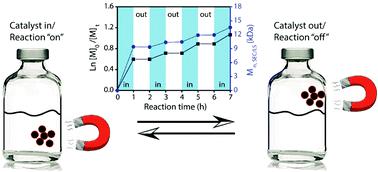当前位置:
X-MOL 学术
›
Polym. Chem.
›
论文详情
Our official English website, www.x-mol.net, welcomes your
feedback! (Note: you will need to create a separate account there.)
Temporal control of RAFT polymerization via magnetic catalysis
Polymer Chemistry ( IF 4.1 ) Pub Date : 2020-03-16 , DOI: 10.1039/d0py00220h Amin Reyhani 1, 2, 3, 4 , Omid Mazaheri 1, 2, 3, 4, 5 , Masood S. Alivand 1, 2, 3, 4 , Kathryn A. Mumford 1, 2, 3, 4 , Greg Qiao 1, 2, 3, 4
Polymer Chemistry ( IF 4.1 ) Pub Date : 2020-03-16 , DOI: 10.1039/d0py00220h Amin Reyhani 1, 2, 3, 4 , Omid Mazaheri 1, 2, 3, 4, 5 , Masood S. Alivand 1, 2, 3, 4 , Kathryn A. Mumford 1, 2, 3, 4 , Greg Qiao 1, 2, 3, 4
Affiliation

|
Magnetic core–shell structured catalysts, Fe3O4@Fe(II)–MOF nanoparticles (NPs), are synthesized in two steps including solvothermal synthesis of Fe3O4 NPs and self-assembly of Fe(II)–MOF particles on the core. They successfully enabled the real time and temporal control of an aqueous reversible addition–fragmentation chain transfer (RAFT) polymerization initiated by the Fenton reaction via an “on–off” reaction at room temperature. The Fenton reaction involves the reduction process of hydrogen peroxide (H2O2) by ferrous ions (Fe(II), inside the MOF), generating hydroxyl radicals (HO˙). These highly reactive radicals, therefore, initiate the magnetic Fenton-RAFT polymerization under ambient conditions. This process leads to the synthesis of controlled polymers with near quantitative monomer conversions, low dispersity values (Đ < 1.10), and experimental molecular weights in good agreement with the theoretical values. The versatility of this system in aqueous media is shown through the polymerization of acrylamide- and acrylate-type monomers including N-acryloylmorpholine, N,N-dimethylacrylamide, 2-hydroxyethyl acrylate, and poly(ethylene glycol) ethyl methyl acrylate, and the formation of polymers with different chain lengths. Moreover, the ‘living’ characteristics of the synthesized polymers are demonstrated with chain extension experiments and Matrix-Assisted Laser Desorption/Ionization Time-of-Flight (MALDI-ToF) analysis. It is expected that the concept of magnetic catalysis could facilitate such temporal control (or “on–off” reaction) over a wide range of polymerizations from a ring opening polymerization (ROP) system where cobalt (or tin)-based catalysts are needed to an atom transfer radical polymerization (ATRP) method where Fe (or Cu)-based catalysts are required.
中文翻译:

磁催化RAFT聚合的时间控制
磁性核-壳结构催化剂Fe 3 O 4 @Fe(II)–MOF纳米颗粒(NPs)的合成分为两个步骤,包括溶剂热合成Fe 3 O 4 NPs和Fe(II)–MOF颗粒的自组装。核心。他们成功地实现了Fenton反应在室温下通过“开-关”反应引发的水性可逆加成-断裂链转移(RAFT)聚合的实时和时间控制。Fenton反应涉及亚铁离子(Fe(II)对过氧化氢(H 2 O 2)的还原过程。),在MOF内)产生羟基(HO˙)。因此,这些高反应性自由基会在环境条件下引发磁性Fenton-RAFT聚合反应。该过程导致受控聚合物的合成具有接近定量的单体转化率,低分散度值(Đ <1.10),并且实验分子量与理论值非常吻合。该系统在水性介质中的多功能性通过丙烯酰胺和丙烯酸酯类单体(包括N-丙烯酰基吗啉,N,N-二甲基丙烯酰胺,丙烯酸2-羟乙酯和聚(乙二醇)丙烯酸乙酯甲酯,并形成具有不同链长的聚合物。此外,通过扩链实验和基质辅助激光解吸/电离飞行时间(MALDI-ToF)分析证明了合成聚合物的“活性”特性。可以预料的是,从需要使用钴(或锡)基催化剂的开环聚合(ROP)系统的各种聚合反应中,磁催化的概念可以促进这种时间控制(或“开-关”反应)。原子转移自由基聚合(ATRP)方法,其中需要基于Fe(或Cu)的催化剂。
更新日期:2020-03-16
中文翻译:

磁催化RAFT聚合的时间控制
磁性核-壳结构催化剂Fe 3 O 4 @Fe(II)–MOF纳米颗粒(NPs)的合成分为两个步骤,包括溶剂热合成Fe 3 O 4 NPs和Fe(II)–MOF颗粒的自组装。核心。他们成功地实现了Fenton反应在室温下通过“开-关”反应引发的水性可逆加成-断裂链转移(RAFT)聚合的实时和时间控制。Fenton反应涉及亚铁离子(Fe(II)对过氧化氢(H 2 O 2)的还原过程。),在MOF内)产生羟基(HO˙)。因此,这些高反应性自由基会在环境条件下引发磁性Fenton-RAFT聚合反应。该过程导致受控聚合物的合成具有接近定量的单体转化率,低分散度值(Đ <1.10),并且实验分子量与理论值非常吻合。该系统在水性介质中的多功能性通过丙烯酰胺和丙烯酸酯类单体(包括N-丙烯酰基吗啉,N,N-二甲基丙烯酰胺,丙烯酸2-羟乙酯和聚(乙二醇)丙烯酸乙酯甲酯,并形成具有不同链长的聚合物。此外,通过扩链实验和基质辅助激光解吸/电离飞行时间(MALDI-ToF)分析证明了合成聚合物的“活性”特性。可以预料的是,从需要使用钴(或锡)基催化剂的开环聚合(ROP)系统的各种聚合反应中,磁催化的概念可以促进这种时间控制(或“开-关”反应)。原子转移自由基聚合(ATRP)方法,其中需要基于Fe(或Cu)的催化剂。











































 京公网安备 11010802027423号
京公网安备 11010802027423号